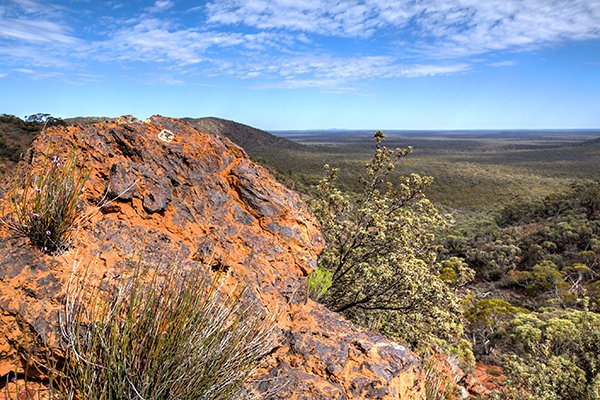WA’s Bungalbin: the Helena Aurora Range

NESTED WITHIN the Yilgarn Shire of southern Western Australia and encompassing the north-western half of the Great Western Woodlands, the Helena Aurora Range is a pristine and old landscape encompassing 40 km of contorted landforms, caves and rocky outcrops.
The region is the largest, highest and steepest banded ironstone formation in Western Australia. No higher land form can be seen over a 400 km radius, making the Helena Aurora Range sight not to be missed when travelling through southern WA.
The Helena Aurora range currently stands as one of the few regions in WA still not affected by mining. It has a rich biota composed of more than 350 species of plants and animals, including five endemic plant species, and the Critically Endangered Leucopogon spectablis, found only on the range.

A Leucopogon spectablis. (Image Credit: Ian Hooper)
This rich biodiversity reflects the ancient refugial role likely played by this region during times of extreme aridity in WA. Much like the monsoonal tropics up north the Helena Aurora Range may have provided a buffered climate and a suitable habitat that allowed the persistence of multiple plant and animal species during epochs of extreme aridity elsewhere in Western Australia.
The Helena Aurora Range is also home of a rich fauna, with over 100 species of reptile, birds, insects, mammals and arthropods. The ecological significance of this area and its diverse fauna has been recognised for years, with the Environmental Protection Authority first recommending its protection as a “A Class’ Nature Reserve”, due to its “of high concentrations of endemic rare flora and priority ecological communities; exceptional landforms; threatened fauna habitats; mature eucalypt woodlands that are declining in the Wheatbelt,” in 2007.
“The value of HA Range is extremely high and irreplaceable, in itself and to the region. The biodiversity and rarity of the flora it supports, including unique vegetation communities cannot be disputed,” says Shapelle McNee, a plant biologist who knows the flora of this range and is currently heading the Helena Aurora Range Advocates organisation, which hosts a wealth of information about the range.

(Image Credit: Rob Neave)
In recent years the Helena Aurora Range has also been the target of mining companies hoping to extract iron ore from the region. So far, the EPA has blocked all proposed mining projects.
A final decision on whether the projects will go ahead now rests with Environment Minister Stephen Dawson, says Jenita Enevoldsen, WA State Director of The Wilderness Society. “This is the first major test for the new government and will demonstrate their respect for the EPA’s recommendations, advice from the scientific community and public environmental concerns,” she says.
“This is the second time the EPA has recommended against these two proposed mines, within two years. With around 40 years of scientific recommendations for permanent protection and 1,500 hundred community submissions rejecting the proposed mines, the future protection of the range needs to be secured,” she adds.
You can help protect the Range and call for a new National Park as recommended by scientists. Sign the petition and send Environment Minister Stephen Dawson a message of support to follow the EPA’s advice.
READ MORE:




